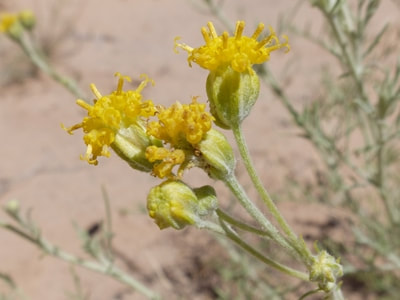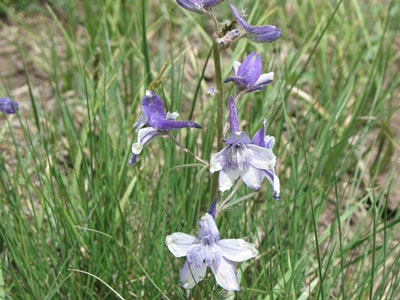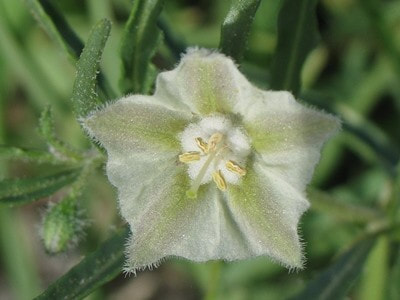White Sweet Clover, Honey Clover, Bee Clover, White Melilot,Melilotus albus,Pea Family (Fabaceae)6/28/2024 The Bloom Blog Blooming this week in the environs of Abiquiú By Wildflowers of the Southern Rocky Mountains Found in disturbed soil, roadsides, streambanks
Seen blooming in June in Red Wash Canyon White Sweet Clover grows with an airy, bushy habit to six feet tall with many branches and tiny, fragrant, white flowers growing in long clusters. Leaves are divided into three leaflets. It could be mistaken for alfalfa before it blooms. It is not native to North America and was introduced from Europe as a forage crop, and is now used to stabilize bare slopes, for soil-building, and is planted by beekeepers for the nectar of its flowers. It likes fire and can erupt in an explosion of growth following a burn. The young leaves can be eaten raw, preferably before the plant blossoms. They are bitter and aromatic, usually used as flavoring in salads. The whole plant thoroughly dried can be used to make a tea with a hint of vanilla. The seeds can be used as a spice. Fermented or moldy clover should never be used. Source. It has been considered a medicinal plant since ancient times; Hippocrates, the father of medicine, used Sweet Clover herb to treat skin ulcers. Sweet Clover produces a coumarin compound that can be converted to dicoumarin, which is used medicinally as a blood thinner and an anticoagulant in rat poisons. It has also been used medicinally to treat external and internal inflammation and stomach and intestinal ulcers. Sweet Clover inflorescences have been used in eye lotions. Source If you are trying to identify a different flower then you can check what other flowers bloom this month. If you cannot identify a flower from the website, send a photo and where you took it to [email protected]. Read online for tips.
0 Comments
The Bloom Blog Blooming this week in the environs of Abiquiú By Wildflowers of the Southern Rocky Mountains Found in dry, sandy, open areas Seen blooming in June on the Espinosa Trail, Abiquiu Fineleaf Hymenopappus is easily overlooked because it has no petal-like ray flowers and small flower heads. It is usually a woolly/hairy plant with stems branching from a rosette or mound of basal leaves. Leaves are twice-divided into narrow or thread-like leaflets which are sometimes covered in woolly hairs, giving a grey appearance. Tubular disk flowers have five lobes and range in color from very yellow to almost white. Thirteen varieties have been identified. This variety, cinerus, grows to 2½ feet high covered in dense white hair in a more rounded bushy form. Basal and stem leaflets are very finely divided. Flowers are less than ½" across and yellow. Traditionally, a poultice of the root with lard was applied to ease swellings, and a decoction of the root was taken as an emetic. The root was also used as a chewing gum, and the leaves were boiled and baked into bread. Source. If you are trying to identify a different flower then you can check what other flowers bloom this month. If you cannot identify a flower from the website, send a photo and where you took it to [email protected]. Read online for tips. The Bloom Blog Blooming this week in the environs of Abiquiú By Wildflowers of the Southern Rocky Mountains Found in meadows, open conifer forests
Seen blooming in June by FS Road 137, Carson National Forest Larkspur grows to eighteen inches high with pale lavender to deep blue flowers, rarely white. The flowers have a long ‘spur’ to the rear of the flower which apparently resembles a Lark's foot structure giving it its common name. Leaves are deeply divided and found mostly on the lower part of the stem. All parts of the plant are toxic and poisonous to livestock, particularly when the plant is young. A blue dye can be made from the flowers, which has also been used as ink. Traditionally, native peoples have used the blue flowers for coloring arrows and other items, or for various ceremonies. Source. \ If you are trying to identify a different flower then you can check what other flowers bloom this month. If you cannot identify a flower from the website, send a photo and where you took it to [email protected]. Read online for tips. Greenleaf Five Eyes, Green False Nightshade,Chamaesaracha coronopus,Nightshade Family (Solanaceae)6/7/2024 The Bloom Blog Blooming this week in the environs of Abiquiú By Wildflowers of the Southern Rocky Mountains Found in dry, sandy areas, roadsides
Seen blooming in June by Hwy 554 near the Forest Service sign Very big names for a plant growing only a few inches high. Greenleaf Five Eyes is a member of the Nightshade family which includes tomatillos and tomatoes and which the flowers strongly resemble. It can grow to 18 inches high with long, narrow, lobed leaves. Flowers are greenish-white with five fused petals and five stamens, about ½ inch across. There are five hairy pillow-like bumps in the center which are presumably the ‘five eyes’. The fruit matures to a whitish berry about ¼ inch across. Chama in the scientific name comes from the Greek word for false. The name Chama, as in the Rio Chama, comes from an Indian pueblo called Tsama near Abiquiu along the north side of the river near its confluence with the El Rito creek. In the Tewa language, Tsama is defined as “wrestling place” or “fighting around place”. Source. The Navajo used the plant for swellings and in cases of drowning. Source. If you are trying to identify a different flower then you can check what other flowers bloom this month. If you cannot identify a flower from the website, send a photo and where you took it to [email protected]. Read online for tips. |
AuthorI am Marilyn Phillips, a native of England, whose love of nature and the outdoors from childhood brought me by a circuitous route to Crested Butte, Colorado in 1993 and 16 years later to northern New Mexico. My exploration of the many trails in these areas, my interest in wildflowers and photography, and career in computer system design came together in this creation. If you have any corrections, comments or questions, please contact me by email. Archives
September 2025
Categoriescopyright © 2020
|






 RSS Feed
RSS Feed